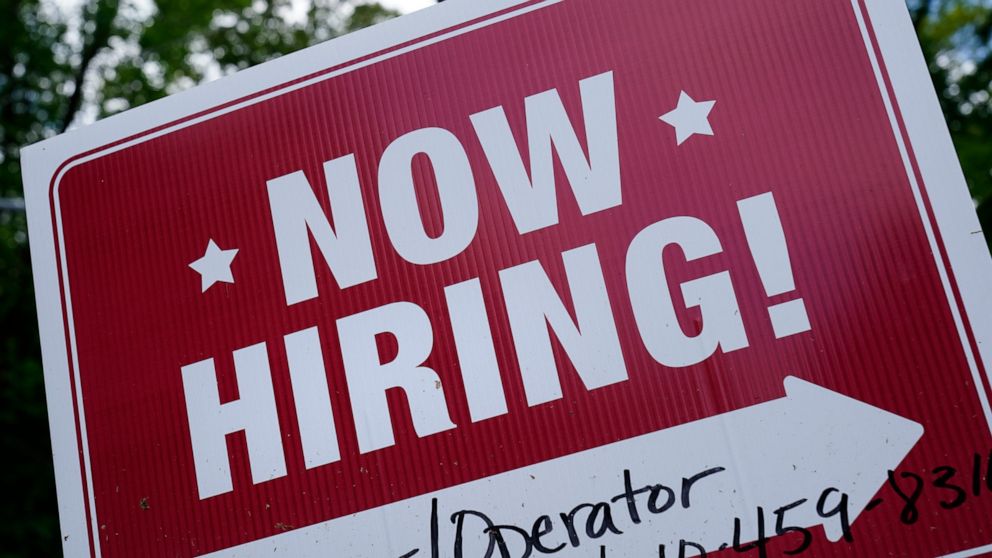US added 431,000 jobs in March in sign of economic health
America’s employers extended a streak of robust hiring in March, adding 431,000 jobs in a sign of the economy’s resilience in the face of a still-destructive pandemic, Russia’s war against Ukraine and the highest inflation in 40 years.
The government’s report Friday showed that last month’s job growth helped shrink the unemployment rate to 3.6%. That’s the lowest rate since the pandemic erupted two years ago and just above the half-century low of 3.5% that was reached two years ago.
Despite the inflation surge, persistent supply bottlenecks, damage from COVID-19 and now a war in Europe, employers have added at least 400,000 jobs for 11 straight months. In its report, the government also sharply revised up its estimate of hiring in January and February by a combined 95,000 jobs.
The March report sketched a bright picture of the job market, with steady hiring and rising wages in many industries. Average hourly pay has risen a strong 5.6% over the past 12 months, welcome news for employees across the economy.
Still, those pay raises aren’t keeping up with the spike in inflation that has put the Federal Reserve on track to raise rates multiple times, perhaps aggressively, in the coming months. Those rate hikes will result in costlier loans for many consumers and businesses. In the meantime, worker pay raises, a response in many cases to labor shortages, are themselves feeding the economy’s inflation pressures.
Since the pandemic struck in 2020, many people have remained on the sidelines of the job market, a trend that has contributed to the worker shortage in many industries. But in an encouraging sign for the economy, 418,000 people began looking for a job in March, and many found one.
Over the past year, 3.8 million people have rejoined the labor force, meaning they now either have a job or are looking for one.
The job growth in March, though solid, was the lowest since September and slightly below what economists had expected. Still, Vincent Reinhart, chief economist at Dreyfus and Mellon, said the numbers show that “the U.S. economy continues to have underlying momentum and that firms are taking workers when they can.”
Across the economy, hiring gains were widespread last month. Restaurants and bars added 61,000 jobs, retailers 49,000, manufacturers 38,000 and hotels 25,000. Construction jobs rose by 19,000 and have now returned to their pre-pandemic level.
Some economists sounded a note of caution, though, suggesting that the prospect of much higher borrowing rates engineered by the Fed will inevitably slow the job market and the overall economy.
“We continue to expect that the Federal Reserve will move rates up expeditiously to counter surging inflation, and that this report only adds more urgency to their plans to do so,’’ said Mike Fratantoni, chief economist at the Mortgage Bankers Association.
For now, the job market continues to rebound with unexpected speed from the coronavirus recession. Job openings are at a near-record level, and applications for unemployment benefits have dropped to near their lowest point since 1969.
Fueled by generous federal aid, savings amassed during the pandemic and ultra-low borrowing rates orchestrated by the Fed, U.S. consumers have spent so fast that many factories, warehouses, shipping companies and ports have failed to keep pace with their customer demand. Supply chains have snarled, forcing up prices.
As the pandemic has eased, consumers have been broadening their spending beyond goods to services, such as health care, travel and entertainment, which they had long avoided during the worst of the pandemic. The resulting high inflation is causing hardships for many lower-income households that face sharp price increases for such necessities as food, gasoline and rent.
The proportion of Americans who are either working or looking for work — the so-called labor force participation rate — ticked up to 62.4% last month, the highest since the early days of the pandemic in March 2020. Even so, the participation rate remains a full percentage point below its pre-pandemic level, limiting the pool of potential job applicants employers can choose from. Many Americans remain on the sidelines because of lingering health concerns and trouble finding childcare.
“You can’t keep adding 400,000 workers a month without running out of workers,” said Reinhart, a former high-ranking Fed economist.
Reinhart said he expects higher interest rates, on top of the expiration of government aid, to eventually slow hiring to “a more sustainable” pace.
“The bad news,” he said, “is we haven’t yet recovered the pre-pandemic level of employment, and it will take longer” to get there.
Karen Fichuk, CEO of the staffing company Randstad North America, noted that the economy now has a record 1.7 job openings for every unemployed person.
“Even if you get all the unemployed workers back, it still leaves a gap,’’ she said. “We need to attract people back into the workforce.’’
In particular, Fichuk said, businesses need to draw more women back by, for example, offering flexible hours and childcare centers or stipends for childcare expenses.
It’s unclear how long the economy can maintain its momentum of the past year, especially as high inflation and the Fed’s rate hikes slow economic activity. Hourly pay, adjusted for higher consumer prices, fell 2.6% in February from a year earlier — the 11th straight month in which inflation has outpaced year-over-year wage growth. According to AAA, average gasoline prices, at $4.23 a gallon, are up a dizzying 47% from a year ago.
Squeezed by inflation, some consumers are paring their spending. The Commerce Department reported Thursday that consumer spending rose just 0.2%% in February — and fell 0.4% when adjusted for inflation — down from a 2.7% increase in January.
At the same time, the job market has kept hurtling ahead. Employers posted a near-record 11.3 million positions in February. Nearly 4.4 million Americans quit their jobs, a sign of confidence that they could find something better.
![]()


